

The first of a two-part story recounts how, after the 1975 fall of Saigon, tens of thousands of persecuted Chinese-Vietnamese fled their country, and how a ship called the Skyluck came to symbolise their long and perilous journey.


The first of a two-part story recounts how, after the 1975 fall of Saigon, tens of thousands of persecuted Chinese-Vietnamese fled their country, and how a ship called the Skyluck came to symbolise their long and perilous journey.
"In office at 07.45 and then at 09.30 it all started: Skyluck cut her anchor chain and drifting. The proverbial hit the fan and we were off.”
June 29, 1979, turned out to be a “day of high drama” for Talbot Bashall, who had recently been appointed controller of the Hong Kong government’s Refugee Control Centre, and he recorded its chaos in his diary.
Bashall’s unenviable task was to oversee the arrival, processing and care of tens of thousands of desperate Vietnamese who, having taken to the high seas, were fleeing their country to seek refuge in the British colony on the southern coast of China. The Skyluck was a 3,500-tonne Panamanian-registered freighter. Its cargo on this day was 2,600 men, women and children, a small cross section of the mass migration of refugees from Indochina that the global media had dubbed “the boatpeople”.
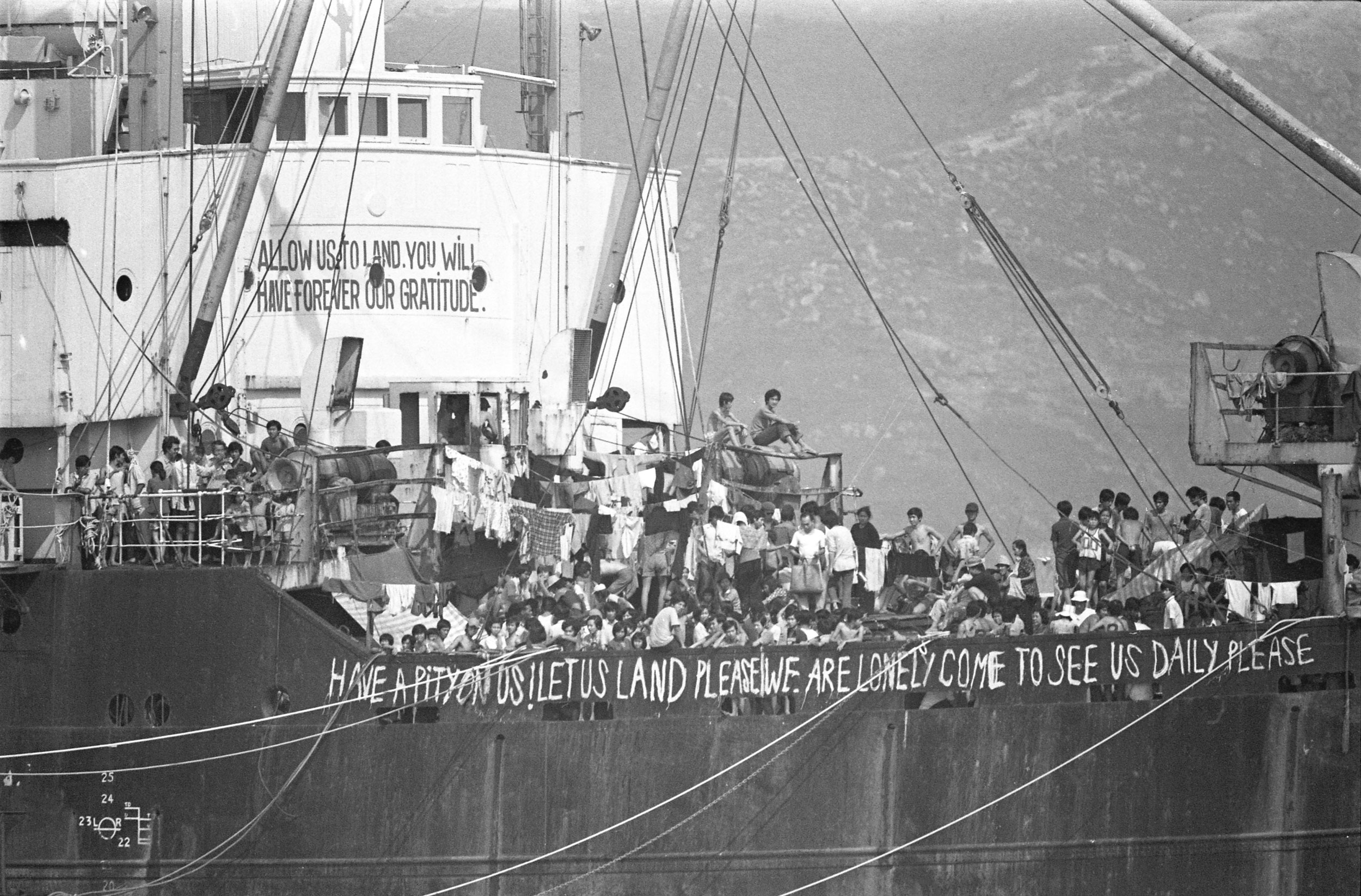
The Skyluck in Hong Kong on April 16, 1979. Picture: SCMP
The Skyluck had stolen into Hong Kong on February 7, more than 20 weeks earlier. Authorities in the territory had refused to let the refugees land, however, keeping them prisoner on the overcrowded ship.
With the Skyluck’s engines immobilised (Hong Kong Marine Police having removed the ship’s fuel pumps), the 105-metre vessel and its increasingly frustrated passengers had been anchored in the West Lamma Channel, between the islands of Lamma and Cheung Chau, for months. Finally, believing they had been abandoned by Hong Kong and the international community, and in a do-or-die move arising from utter despair, the refugees had severed the Skyluck’s two anchor chains – as a storm approached – and now, under a bruised sky, buffeted by strong winds, and pushed and pulled by fierce currents, the colossal ship was loose and out of control.
Police launches and salvage tugs were rushed to the scene, scrambling to get lines to the stricken vessel, but their crews were pelted from the Skyluck with bottles, cans and flaming Molotov cocktails. At the top of the ship’s gangplank, one refugee waved an axe to keep the police at bay.
Less than two hours later, the Skyluck’s portside flank smashed into rocks at the north-western tip of Lamma, where, at the mercy of heavy swells and grinding on bare granite, it began taking in water. While the younger and fitter refugees shimmied down rope ladders and cargo nets to run for the hills, many of the elderly and very young waited on board, or huddled by the water’s edge, tired, forlorn and wretched in the rain.
The Skyluck’s journey had come to an end. Those of its passengers had just begun.
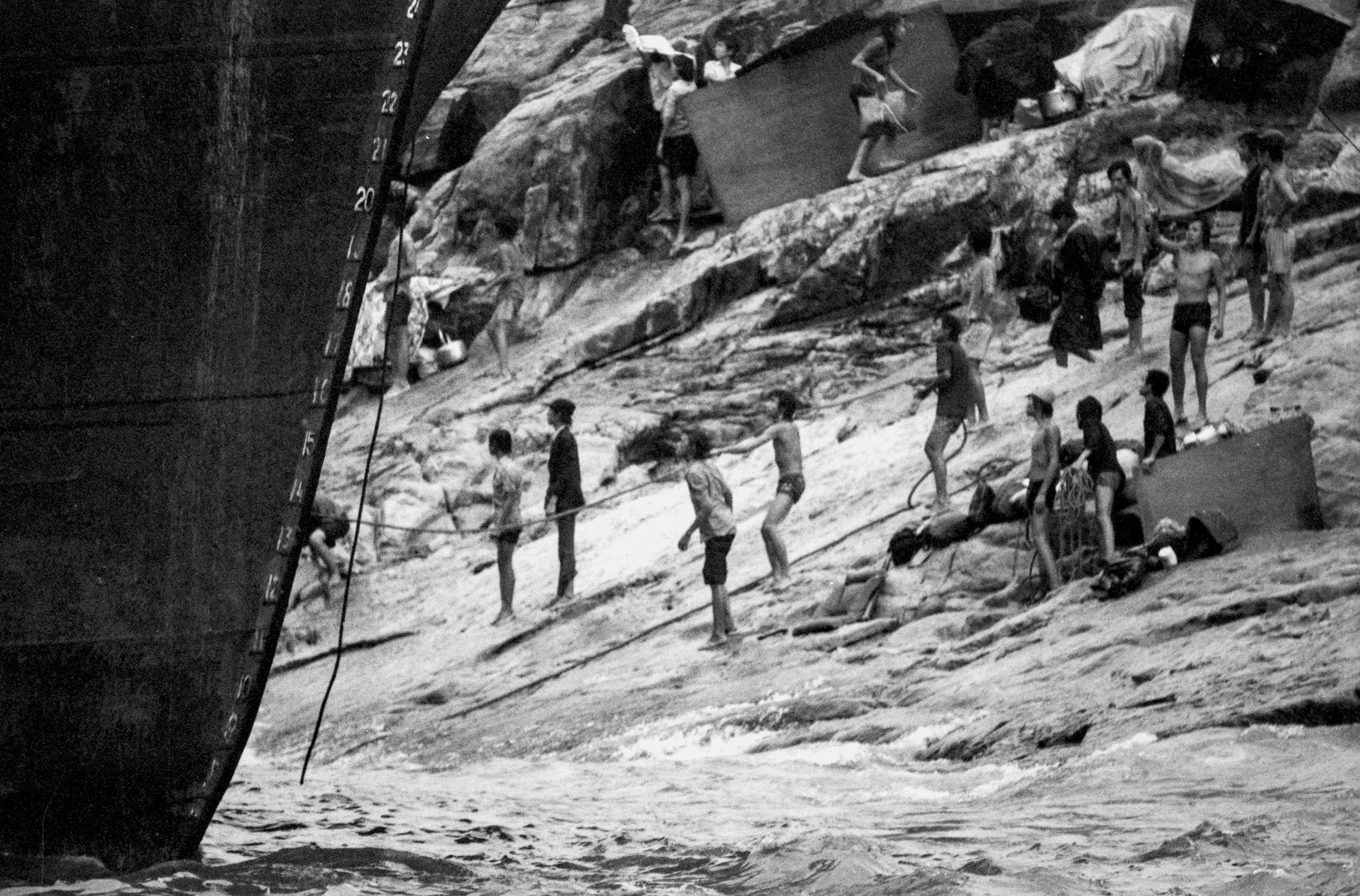
Vietnamese boatpeople, including a youthful Bryan Chan (third from left), signal up to the beached freighter from the Lamma shore. Picture: SCMP
Four decades later and I am in San Jose, a Silicon Valley city on the southern edge of San Francisco Bay, in northern California. San Jose has a population of one million, with 10 per cent and 7 per cent, respectively, claiming Vietnamese or Chinese heritage. (San Jose, in fact, is believed to have the largest Vietnamese population of any city outside Vietnam.)
Signs at the bus station are in English, Spanish and Vietnamese. My Mercedes-piloting Uber driver is Vietnamese. He drops me at a shiny shopping-and-dining complex called Vietnam Town, where I have a lunch appointment at a Chinese seafood restaurant that, with its circular tables, bright lighting and cacophony of voices, could be in Sheung Wan or Shenzhen.
A convoy of cars (including more Mercedes) makes circuits of the car park. Flags waved from windows are either the Stars and Stripes of the United States or yellow with three horizontal red stripes – the standard of the erstwhile South Vietnam. Protesting modern Vietnam’s larger and increasingly assertive neighbour’s claim to the Spratly Islands, in the South China Sea, banners and placards read, “China Get Out of Vietnam Waters Now!”
Five members of a Chinese-Vietnamese family have invited me to join them in a private room at the restaurant, to recall their epic voyage to Hong Kong, and how that journey was the springboard to new lives in America’s Golden State. Andy Tran, brother Bryan Chan and sister JoAnn Pham, and their cousins Bill Quach and Richard Quach were all aboard the Skyluck when it slammed into Lamma Island, along with 12 other members of their extended clan. Andy and Bill live in San Jose, with the others scattered across the Bay Area.
“Everyone had grown so tired, they would take any risk,” Andy Tran, now aged 60 (and 20 when he fled his homeland in 1979), says of the day he finally set foot on Hong Kong soil.
“Once the chain was cut, the Skyluck started drifting. At first, the Hong Kong police didn’t know what was going on. They shouted, ‘Don’t panic, we will throw you a rope and pull you back out.’ Then everyone went, ‘Ha ha ha, not a chance.’ When they threw the rope up, we threw it back.” says Andy Tran.
Taking risks was by now second nature to those aboard the Skyluck. Many had sacrificed everything – settled lives, houses and possessions, family members they might never see again – in their all-or-nothing quest to escape their homeland and find new homes.
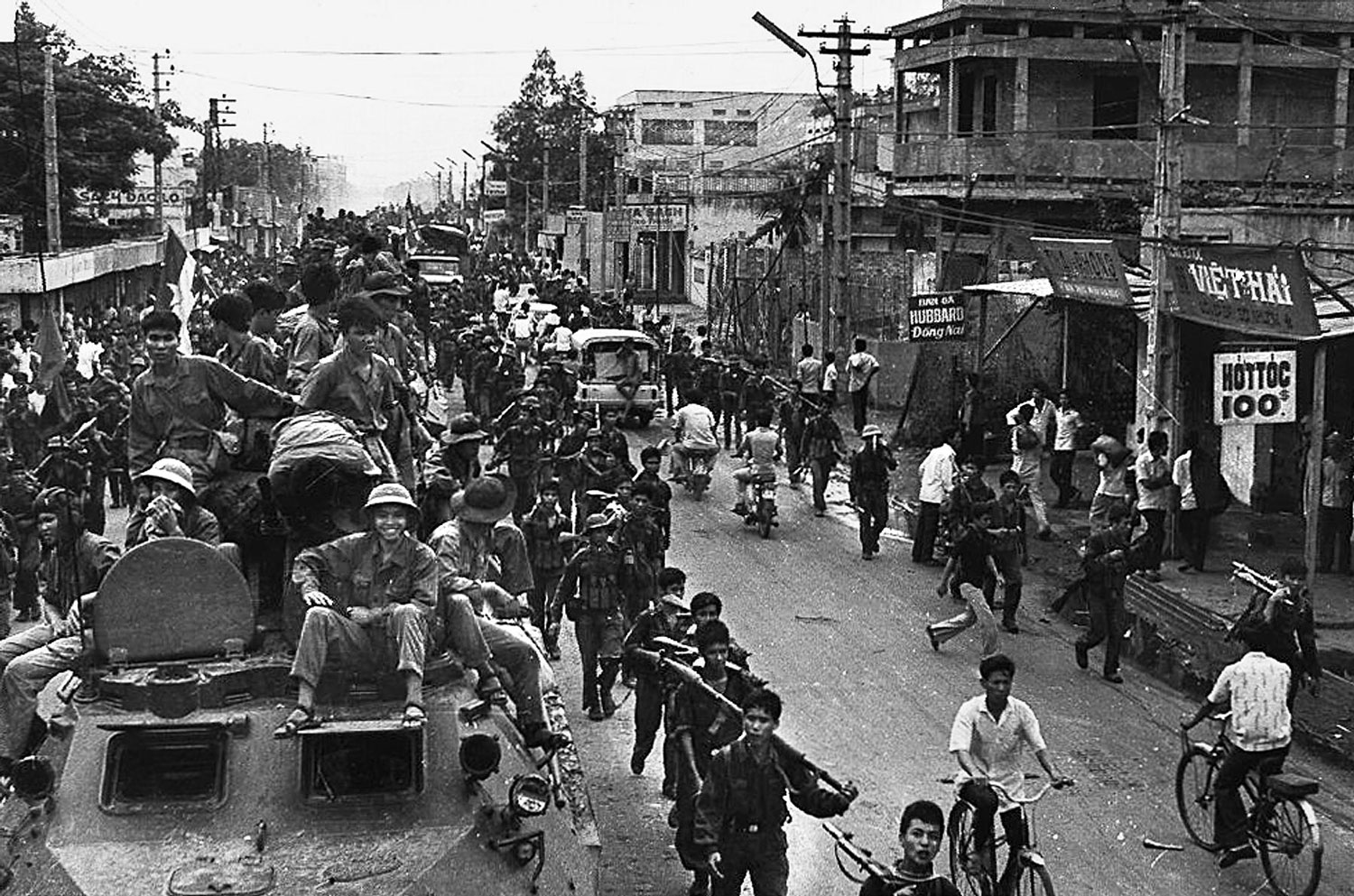
Communist troops make their way to the centre of Saigon having taken control of the city, on April 30, 1975. Picture: AFP
On April 30, 1975, with the fall of Saigon, the capital city of South Vietnam, to the communist North, the long Vietnam war came to an end. The following year, Saigon would be renamed Ho Chi Minh City, in honour of the North’s late revolutionary leader.
With the country soon to be officially unified under the Communist Party of Vietnam, the bloody revenge against the people of the South (that many had anticipated) did not materialise. Once the dust of conflict had settled, however, as many as 300,000 people, especially those associated with the southern government and military, were sent to re-education camps to be “reformed” through hard labour and political indoctrination.
A further million, mostly city dwellers, were dispatched to “new economic zones”, essentially primitive agricultural communes where, if they were to survive, they would have to clear malaria-infested jungle and try to grow crops. In 1976, French journalist Jean Lacouture described one zone he visited as “a place one comes to only if the alternative to it would be death”.
Such treatment, as well as growing economic hardship and food shortages, saw the persecuted taking to the high seas – often in clapped-out fishing junks entirely unsuited for long-distance journeys – hoping to find sanctuary in Southeast Asian countries such as Thailand, Malaysia, the Philippines and Indonesia. Many would not survive the passage, succumbing to storms and shipwreck, murderous pirate attacks, boat breakdowns and starvation.
The numbers of boatpeople were initially small. By the end of 1975, some 3,900 had arrived in Hong Kong, to be accommodated in hastily prepared camps. The government observed a “first asylum” policy whereby the colony provided shelter to refugees if Hong Kong was their first port of call, and the Office of the United Nations High Commissioner for Refugees (UNHCR) sent representatives to the city to assist. With the volume of arrivals being low, refugees were quickly resettled overseas, most notably to the US.
By 1978, however, the trickle had become a flood (at its height, in 1979, more than the total number of refugees that arrived in Hong Kong in 1975 landed in the city in a single day). This was largely due to the forced socialist remoulding of industry and harassment of Vietnam’s ethnically Chinese population, who had historically dominated commerce, especially in the South. In March 1978, “all trade and business operations of bourgeois tradesmen” were abolished in Vietnam, and tens of thousands of private enterprises were shut down.
Completing the perfect storm, tensions were rising on the Vietnam-China border throughout 1978 (resulting in China’s invasion the following year), the Vietnamese government increasingly viewing the country’s ethnic Chinese as potential fifth columnists and a threat to national security.
Fifth-generation members of an ethnically Chinese family in Vietnam, my San Jose dining companions had lived in a Chinese neighbourhood in Saigon. Andy Tran describes the family as being upper-middle-class at the time. They spoke Cantonese, and sometimes Fujianese, with family, friends and neighbours, and Vietnamese at school, where they also learned Mandarin. “My family sold materials – copper, steel, iron bars – to the construction industry. [Cousin] Bill’s father was working in coffee distribution and retail.”
Their businesses, however, were forced to close.
The family group’s escape from Vietnam began in mid January of 1979, when they trekked to the languid riverside town of Ben Tre, in the Mekong Delta area of southern Vietnam, about 80km southeast of Ho Chi Minh City. In the delta, the mighty Mekong river, having meandered 4,300km from the Tibetan Plateau, empties into the South China Sea.
In the years immediately after 1975, authorities would try to stop all Vietnamese fleeing the country by boat. By late 1978, however, regime officials were accepting under-the-counter payments to look the other way, and the cash-strapped government not only encouraged the migration – wanting the Chinese-Vietnamese gone – but also saw the opportunity for profit.
When the North’s tanks had rolled into Saigon in 1975, many Chinese-Vietnamese had hidden their wealth, often in the form of 24k gold bars. Now, Vietnamese authorities (notably the Cong An, the Public Security Bureau, effectively the police), in collusion with shady international syndicates, racketeers and unscrupulous foreign ship crews, would facilitate their evacuation.
“The communists figured out, ‘If we let them go, they’ll pay us and we can take their houses. What a deal!’” says Andy Tran. “The benefit of paying the government was that you would not be caught and sent back. They would let you go.” And the downside? “You’d have to give them everything you left behind.”
My grandmother gave everyone a small gold ring to wear, pure gold, so if we became separated, each of us would have something we could sell. We also carried some US dollars, though not a lot”Skyluck survivor Andy Tran
Despite denials by Vietnamese officials, all evidence pointed to state-sanctioned people smuggling on a monumental scale.
According to accounts of refugees who spoke to Post Magazine for this story (individuals named here as well as others who chose to remain anonymous), an adult would be charged, on average, 10 to 12 taels of 24k gold for space on an escape ship (one tael being 1.2 troy ounces); the fee for children was lower and dependent on age. The price of gold in January 1979 hovered at about US$240 an ounce, so an adult would have been paying around US$3,000, the equivalent today of more than US$10,000.
After a few days of waiting nervously in Ben Tre, the group of 17 was summoned on a date believed to have been January 19, 1979, and boarded a wooden fishing boat taking refugees out to sea.
“We didn’t take much; a little emergency food like instant noodles, because we thought out there we would have nothing, and cans would be too heavy, so easiest would be some crackers and dried food like noodles,” Andy Tran says. “We thought we might not have hot water, but at least you can chew on them. Possessions? Only what we could hand-carry.”

Each person in the group also carried what Tran describes as “self-survival necessities” for emergencies. “My grandmother gave everyone a small gold ring to wear, pure gold, so if we became separated, each of us would have something we could sell. We also carried some US dollars, though not a lot.”
The group did not know where they were heading, only that they were leaving. “We’d just been told we would get out,” says Andy Tran. “The journey was not to anywhere, but to somewhere. Once out, we’d be on our own.”
Having headed out to sea, within hours their small craft was swallowed up by the shadow of an immense ship called the Kylu, its name daubed in large, white letters on the bow and stern of a rust-streaked hull, its deck dominated by a tangle of cargo cranes. Loading took days, says Tran.
Finally, on Wednesday, January 24, 1979, the Kylu – now crammed with some 3,200 refugees – set sail into the unknown.
We were the defeated side. I knew at that time that my children would have no future; they would never get to high school. So I thought we had better get out of the country, to find a better life for my children”Skyluck refugee Quan Tran
Exactly one week after our lunch in San Jose, it is a blue-sky winter’s day in Washington DC, on the opposite side of the US. Descending into a funky basement coffee shop (its website describes “a Cultural Salon; an Intellectual Sanctuary”), I find myself taking the stairs immediately behind Quan Tran and his son, Thuan “Tom” Tran, the very people I have arranged to meet.
The coffee shop is in the Adams Morgan area of the US capital, a diverse neighbourhood celebrated for its lively nightlife and dining scene. While 42-year-old Tom (close buzz cut; jeans; purple hoodie) lives nearby, Tran senior, who is now 71, resides in the town of Silver Spring, in Maryland, the state immediately to the north. His olive-green knitted hat matches his quilted North Face jacket, he smiles readily and his short but thick dark hair is only slightly flecked with grey, belying his years.
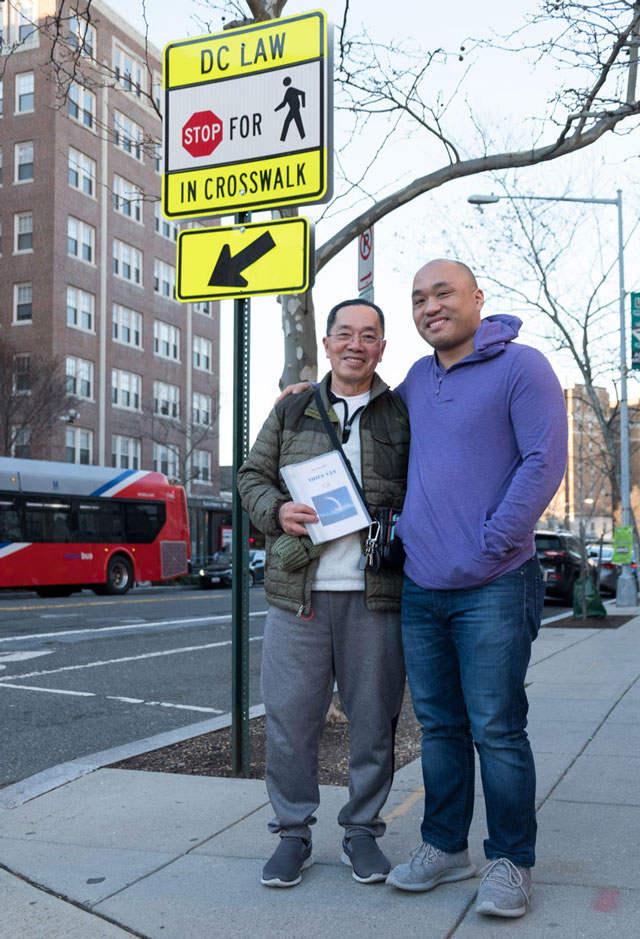
Quan Tran and his son, Thuan “Tom” Tran, in Washington DC. Picture: Gary Jones
Quan Tran carries the manuscript of a book he has written, in Vietnamese, “for my family”. It is about their epic voyage to Hong Kong and titled Thiên Van, a literal translation of “Sky Luck”, though Tom later explains that more accurate English rendering of the Vietnamese might be “divine destiny” or “heavenly fate”.
In Vietnam, Quan Tran’s family lived between central Saigon and Cholon, the latter originally being a community, located about 10km west of Saigon proper, established by Chinese immigrants in the 18th century. Cholon was recognised as a city in its own right in the 19th century, and has long since been absorbed into the urban sprawl that is Ho Chi Minh City.
Quan Tran’s parents ran a restaurant; he had been an instructor at Saigon’s mechanical engineering school before being drafted into the South Vietnamese army for two years of the war, serving as a lieutenant. With the South’s collapse, he was sent to a re-education camp, but laboured there, he says, for less than five months because his teaching skills were needed.
Once back at the engineering school, however, Quan Tran could see just how much life had changed for the people of the South. “We were the defeated side,” he says. “I knew at that time that my children would have no future; they would never get to high school. So I thought we had better get out of the country, to find a better life for my children.”
Like Andy Tran in San Jose, Quan Tran left Vietnam in a large group, this time of 15. They included his wife (who, like Tran himself, was 30 at the time) and their two children (daughter Thao, then aged four, and Tom, only days away from his second birthday), as well as three sisters, one brother, three cousins and four more-distant relatives.
Also like the Californians, their departure point would be Ben Tre, where Quan Tran was introduced to the owner of the fishing boat that would be his family’s means of escape. The man needed a mechanic and by taking the role, Quan Tran would not need to pay to get out, handing over only six ounces of gold for his wife and three ounces for each of his children. “My sisters and cousins paid 12 ounces of gold each,” he says.
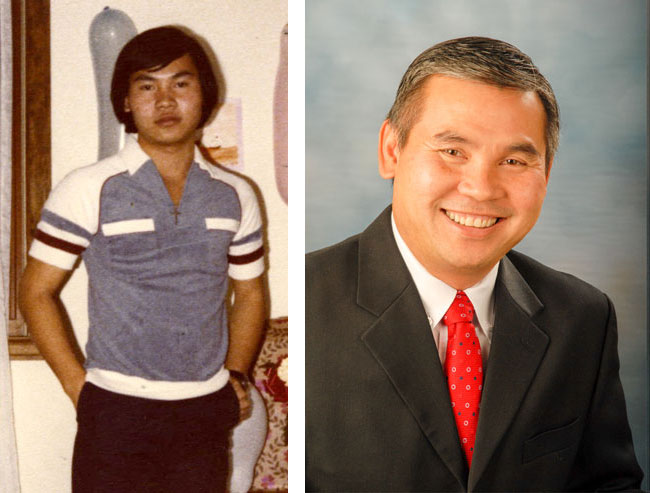
Mai Tran, in 1980, soon after his arrival in the United States. (Right) Mai Tran today. Picture: courtesy Mai Tran
As the day to leave drew closer, those waiting in Ben Tre learned of how large ships, which would be significantly safer on the seas than rotting, overloaded fishing boats, had been used by other escapees. Most notable would have been the 4,000-tonne freighter Huey Fong, which had left the Mekong Delta on December 18, 1978, carrying some 3,300 refugees.
The Huey Fong’s intended first port of call was Kaohsiung, in Taiwan, and so it was initially refused entry to Hong Kong. The ship had been intercepted by Marine Police off the Po Toi islands (5km southeast of Hong Kong Island), but was finally received on January 19, 1979, news that was reported on radio stations such as the BBC World Service and Voice of America.
“We asked the police if we could go in a similar way to the Huey Fong and the police said maybe,” says Quan Tran. “They didn’t promise, but then they said they had a big ship for us. They said there was one condition: if they transferred us to the ship, we would have to give them our boat, so that they could sell it.” The fishing boat owner and members of his family would also join the Kylu. “That was the agreement between us and the police.”
Quan Tran says his fishing boat, carrying what he estimates to have been 120 to 150 people, was one of the first to reach the Kylu. “We were waiting, waiting, and they keep loading people on, back and forth, back and forth. I think it took three or four days before the captain said OK, enough, and took us away.”
On our boat – a small, wooden fishing boat – there were 200 to 300 people. It took maybe two or three hours before we could see the ship. Getting aboard was really dangerous – we had to climb up these nets that hung down”Refugee Mai Tran
Sixteen-year-old Mai Tran and sister Thu-Hong, aged 14, were also aboard the Kylu when it set sail.
The siblings’ father had been a South Vietnamese diplomat, stationed in the late 1960s and early 70s at the embassy in Bangkok – the family living in the Thai capital – before returning to Vietnam in 1972, to work in government in Saigon. With the end of the war, Mai Tran’s father and uncles were sent to re-education camps; Tran’s mother eventually bribed an official to have her husband released.
The couple had six children – four girls and two boys – and, says Mai Tran, they tried to escape from Vietnam as a family five times from 1976, but were caught, his elder sisters being punished with spells in prison. By 1979, a decision had been made: the family would split up for future attempts. Mai Tran and Thu-Hong would go first.
Having learned of how Chinese-Vietnamese were being permitted to escape from the country, Mai Tran’s parents took the two children to the Mekong Delta.
“From Saigon, we went to my mother’s hometown, Ben Tre, where we were met by the local official. They put us into police housing while we waited,” Mai Tran, 55, says by telephone from his home in Fort Collins, in the US state of Colorado. “From there, they took us to Binh Dai, which is the town near the ocean, where we got on the boat. We waited there a week.”
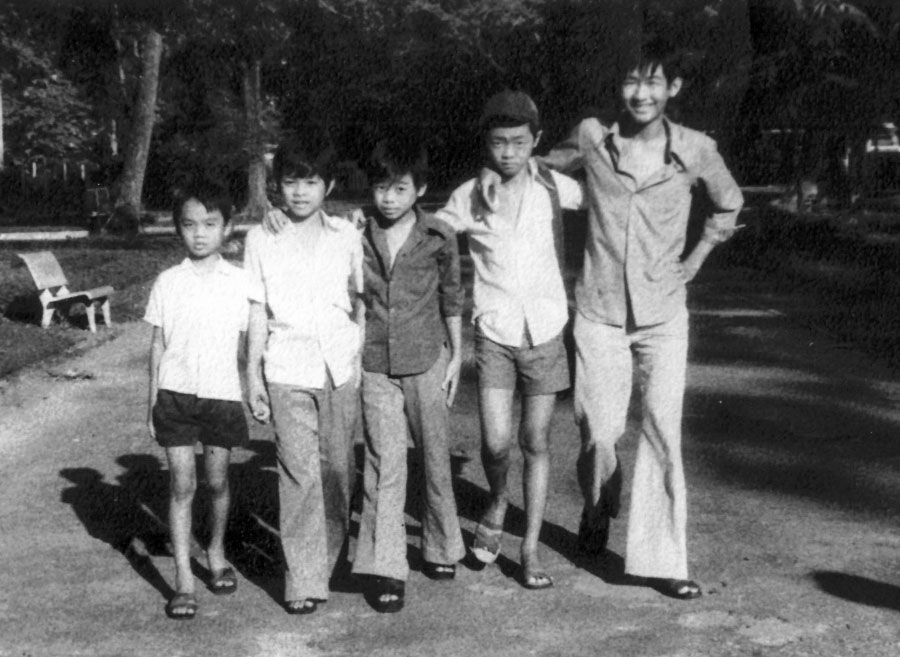
(Left to right) Bill Quach, his cousin Ahdee Chan, brother John Quach and two neighbours in Ho Chi Minh City, in 1978 or January 1979. “This was the last picture we had before we left Vietnam,” says Bill Quach. “We cut classes to go to the zoo.” Picture: courtesy Bill Quach
Mai Tran’s parents paid 15 ounces for each child, and gave him a 24k gold wedding band that could be sold in an emergency. “We had small bags with just two or three sets of clothes,” Mai Tran says, adding that they also had no idea where they would be heading. “We only knew that we were getting out.”
“On our boat – a small, wooden fishing boat – there were 200 to 300 people. It took maybe two or three hours before we could see the ship. Getting aboard was really dangerous – we had to climb up these nets that hung down.” Mai Tran says he and his sister left Binh Dai early one morning.
Once aboard, the youngsters had to fend for themselves. “We settled in. No cabins, just out in hallways; no beds, just anywhere where you can sit or lay down. For two, three days or more, more people were coming, coming, coming.”
Soon the deck was a chaos of makeshift tents and tarpaulin shelters. Below deck, the ship had three main cargo-storage areas, each split into upper and lower holds. The higher levels filled up first – the dank, dingy bowels still containing some cargo in the form of huge rolls of paper. “There was a space between the first and second floors, about a metre-high,” says Mai Tran.
“There were about six other kids without parents, and that’s where we went, and we would sleep between the paper rolls. Nobody else wanted to be in there – it was dark – so we stayed separate from the main population. They called us ‘the paper kids’.”
We took an old oil container, a 55-gallon drum, cut it in half, cleaned it with salt water, and cooked in that. That’s why we ate rice soup with a diesel smell”Quan Tran
Quan Tran, in Washington DC, says the Kylu’s captain had told him the ship would steer for Hong Kong, to the northeast, but once on the move, he realised this could not be the case. “Each day, I went up to the control cabin to see where the ship was going. I know that at first they go south, but I don’t know where. One day, we saw offshore drilling [possibly for oil or gas], so we thought maybe we were close to Malaysia or Thailand.”
The arrangement that Quan Tran and others had made was simply to get out of Vietnam, hopefully to reach a refugee camp, or perhaps to be picked up at sea by a friendly naval vessel, and to be resettled in another country. Where they would land first was not important.
What quickly became the most pressing issue was food. Quan Tran says he initially recalls sandwiches and crackers being provided, but they ran out after just a couple of days. “There were 3,000 people, and they did not have enough food for us, so we had to organise cooking rice soup, but there was nothing in which to cook it. We took an old oil container, a 55-gallon drum, cut it in half, cleaned it with salt water, and cooked in that. That’s why we ate rice soup with a diesel smell. The ration was a cup of rice soup for each person, two times a day."
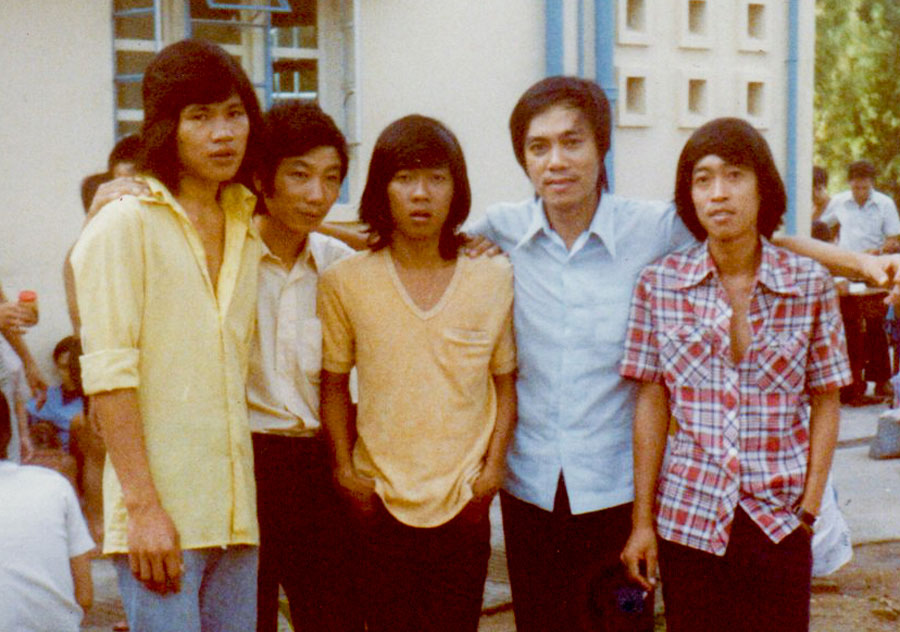
Quan Tran (blue shirt) and friends from the Skyluck, in the Chi Ma Wan refugee detention centre on Lantau island in 1979. Picture: courtesy Quan Tran
For Andy Tran’s sister JoAnn Pham, who was 13 while on the ship, and now aged 53, the rice soup was so unappetising it seared into her child’s brain. “The worst thing I remember is the porridge cooked in a barrel. Yeuch! You could taste the metal. It was water and just a little rice, and all these other …” – she scrunches her face in disgust – “bits”.
Mai Tran has no recollection of sandwiches, and remembers even more meagre rations. “The food was rice soup, once a day,” he says. “There was no fixed time, it just came when it was your turn. That’s all we had for five to six days.”
The food shortage occurred, the refugees believe, because there were far more people on the ship than had been planned. Though it is true that large numbers of ethnically Chinese were fleeing Vietnam, and big ships and freighters were laid on by people smugglers for those willing to pay to escape, many on board were effectively stowaways, or had been forced aboard, and a large proportion were not Chinese at all.
While the Tran and Quach families, now living in California, are of Chinese ethnicity, only one grandfather of Maryland-based Quan Tran was Chinese, and he considers himself fully Vietnamese. Mai Tran claims no Chinese ancestry at all, which may account for why his parents paid over the odds: 15 ounces of gold for his journey, and 15 for that of his sister.
Years later, after being reunited with his parents, Mai Tran would learn more about the deal they struck to get him out of the country. “According to my mom, they only anticipated 600 to 800 people who paid, but in the end there were 3,000 people. Almost the whole of the village at Binh Dai, they knew what was happening and they used [the ship] as a way to get out as well. Those people were Vietnamese and they got on for free.”
“[The authorities] hired a lot of locals to transport us, and some of them saw an opportunity,” says Andy Tran. “When they transported us, they also came aboard.” The result, he adds, was that many paying customers were stranded in Ben Tre when shuttle boats failed to return from the Kylu. “I happened to run into one who […] didn’t get on because his fishing boat never came back to pick him up. His taxi never came.”
And, according to Quan Tran, there were Chinese-Vietnamese on board who had not intended to escape at all. “Lots of people in Ben Tre were forced out of their homes in the night because they were Chinese,” he says, adding that while they would not have paid a fee, the Cong An would have seized their homes and belongings.
It was maybe 5am. My family and I were close to the ladder – I saw the transfer boat that took people from the ship. Then I heard shots and I saw a flare, and the ship’s crew said the Philippine navy was firing on us, and we had to get away”Quan Tran
In the closing days of January, the Kylu entered waters of the western Philippines and verdant tropical islands hoved into view. On the evening of January 31, the ship cautiously edged closer to one island and dropped anchor. Soon, refugees were queuing on the freighter’s deck, to descend the gangway to water level and be ferried ashore under cover of darkness.
Mai Tran says he saw a chance to assuage their gnawing hunger. “I said to my sister and some other kids, ‘Why don’t we just stay back and try and find some food first?’” The youngsters went to where the rice soup was prepared each day, and found the barrel in which it was boiled. “We scraped out the burnt rice at the bottom to eat.”
Mai Tran was also anxious about leaving the ship’s protection in darkness. “We couldn’t see anything. I said, ‘Let’s wait until morning,’ so our group, us kids, that’s what we agreed to do.” Mai Tran’s caution would lead to “the paper kids” being stuck at sea for five more months.
Come the half-light of the approaching day, more than 600 refugees had been offloaded from the Kylu when the operation was hastily abandoned. “It was maybe 5am. My family and I were close to the ladder – I saw the transfer boat that took people from the ship,” says Quan Tran. “Then I heard shots and I saw a flare, and the ship’s crew said the Philippine navy was firing on us, and we had to get away.”
Andy Tran’s account is similar. “Around dawn, a fishing boat saw us and maybe reported us to the coastguard, so the Philippine navy come out to see what is going on, and we pulled anchor and sailed out of there.”
Meanwhile, in Hong Kong, some 1,400km to the north, 3,274 taels of gold (close to 4,000 troy ounces, then worth almost US$1 million), had been found secreted in a disused oil tank on the Huey Fong, to be confiscated and held at the Treasury. The discovery would have a profound effect on the fate of the refugees chased away from Philippines.
Four decades later, what came next for the Kylu is disputed. Though many survivors of the journey are adamant about events they witnessed – and when those events occurred – their personal recollections (like many news reports from the time), while similar, are inconsistent.
The accounts of Andy Tran and Quan Tran (who, as far as they are aware, have never met) are alike in many respects. Both claim that soon after fleeing the island in the Philippines, which would likely have been on February 1, they rendezvoused at sea with another large freighter. Andy Tran says he witnessed gold being removed from their ship, while Quan Tran suspects this to have been the case.
“The captain said we would meet another ship that would give us food,” says Quan Tran, adding that supplies were shuttled over in a lifeboat, and everyone gathered on one side of the ship to watch. “Meanwhile, they took another boat to the other side [of the Kylu], with the stairs. I went to that side and saw some people. They were not like us; they had nice clothing, not like refugees. I don’t know if they transferred the gold. They had guns. I saw two people with rifles.”
“They parked another ship next to [ours] and transferred the gold over, guarded by sailors with M16s,” says Andy Tran. “They said, ‘Don’t cross this line. This is the open sea, anything can happen here. Cross this line and you’ll be shot.’ We saw them carry the gold across, and carry food back for us.”
Frank Tran, late brother of Andy Tran, Bryan Chan and JoAnn Pham, and who was 17 at the time, kept a journal documenting the family’s escape from Vietnam. Later – while being treated for the cancer that took his life in 2011, at the age of 49 – he created a website about the journey (skyluck1979.com). That website also suggests a meeting of ships soon after the Kylu was chased away from the island in the Philippines.
And another US-based refugee from the ship who spoke to Post Magazine recalled heavy bags being taken away on that day, while “men with M16s ensured we stayed at a distance”.
Other accounts of the journey, however, suggest they were met at sea by a freighter in the days or the day before the attempted dumping of refugees. For his part, Mai Tran says he recalls meeting two ships, each on a different day. “On the way from Vietnam to the Philippines, there was a ship that stopped, and people said they took the gold,” he says. “Then, when we left the Philippines, there was another ship that swung by and dropped off food.”
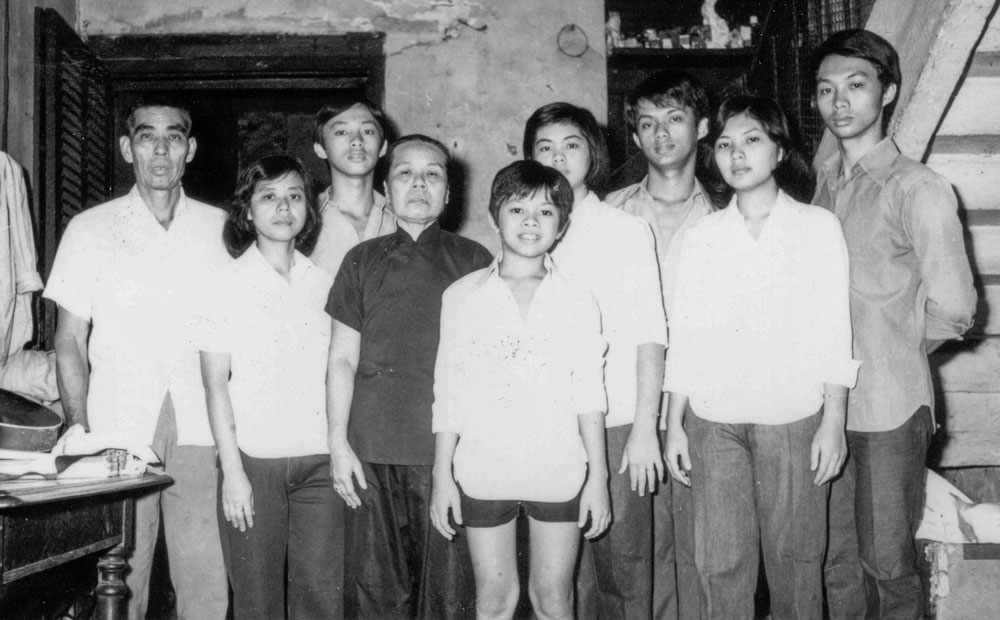
Members of the Tran/Quach family in Ho Chi Minh City, Vietnam, in 1978, including Bryan Chan (third from left). JoAnn Pham (fourth from right), Frank Tran (third from right) and Andy Tran (far right). Picture: courtesy Bill Quach
Though the Kylu had a captain – from Taiwan – and crew, the refugees had largely been left to their own devices while at sea, and a loose organisational hierarchy had evolved out of necessity, primarily to oversee food distribution.
While some refugees were accorded positions of responsibility because of Mandarin-language skills that allowed them to liaise with the captain, leadership roles were mostly taken by men, in their 20s or early 30s, who had served with the South Vietnam armed forces. Quan Tran was among them.
The refugee leaders demanded the captain tell them of his next move, and they were told Hong Kong was now their goal. Quan Tran claims, however, that the following day (February 2) the ship was again heading south, and in the wrong direction. With the refugees angered and unwilling to accept more delays, Quan Tran describes what happened next as “a little bit of a takeover”.
“When the captain saw that we were a big group, he did not yell at us like he had [earlier in the journey]. He asked what we wanted. We said he had not kept his promise, so we wanted to take over the ship and go to Hong Kong.”
Quan Tran says the captain partially agreed to their demands, but argued that the ship must, for appearances’ sake, remain under his control lest the refugees become open to accusations of piracy, and they accepted this compromise. “After that, I saw a telegram [to the captain, from his controllers], agreeing that we could go to Hong Kong.” The message, Quan Tran alleges, also ordered the captain to have the ship’s name repainted.
In short order, crew members added the letters S, C and K to the ship’s hull, and the freighter reverted back to its real name. The Kylu, of course, had always been the Skyluck in disguise. And now, loaded with the remaining 2,600 or so refugees, it was steaming towards Hong Kong.
Everyone had been told to get inside, so we just looked like any other commercial ship. As soon as the anchor was down, I remember everybody came up and went to one side to look, and the ship started tipping. We could see all the lights. It was beautiful”Mai Tran
It was not the first time that the long-serving freighter had plied the oceans under another name.
While under construction, by Henry Robb Ltd, a substantial Scottish shipbuilding concern at Leith Docks, in the Scottish capital of Edinburgh, the vessel was called the Kurutai. Delivered in 1951 to the Union Steam Ship Company, in New Zealand, the vessel was then given the name Waimate.
In 1972, the Waimate was restyled Eastern Planet by its new owner, Manila-based Eastern Shipping Lines, and five years later, in 1977, it was purchased by the Hong Kong-owned Skyluck Steamship Company, and rebranded once more. Soon the name Skyluck would be notorious throughout Hong Kong, the ship commanding front pages of the city’s newspapers and prime slots on the evening news.
In the early hours of February 7, 1979, the Skyluck (as reported by the South China Morning Post the following day) “ignored signals from Waglan Lighthouse” – on Waglan Island, one of the Po Toi islands – and slipped into Victoria Harbour, anchoring off the southwest of the Kowloon peninsula, not far from Ocean Terminal.
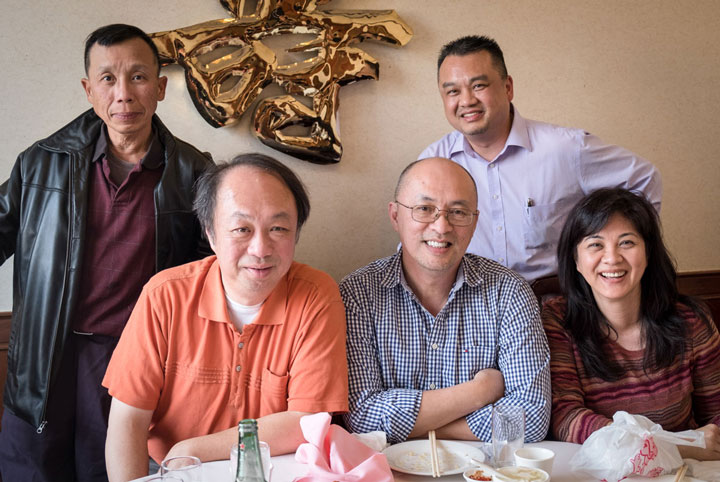
California-based siblings (seated, from left) Andy Tran, Bryan Chan and JoAnn Pham, and their cousins Richard Quach and Bill Quach (standing, from left), pictured over lunch in San Jose. All were Vietnamese boat people who arrived in Hong Kong in 1979 aboard the Skyluck. Picture: Gary Jones
“We had been living all over the ship – in the cargo hold, all over the deck – but as we approached Hong Kong, we were told to throw all the tents from the deck overboard, and hide away in the hold,” says Andy Tran. The idea was not to look like “a floating refugee camp”, he adds. “We quietly entered Victoria Harbour at night-time, at about 1am or 2am.”
“Everyone had been told to get inside, so we just looked like any other commercial ship,” says Mai Tran. “As soon as the anchor was down, I remember everybody came up and went to one side to look, and the ship started tipping. We could see all the lights. It was beautiful.”
According to the Post’s account of the Skyluck’s arrival, marine police boarded the ship after reports of disturbances on board, to discover human cargo numbering in the thousands and the captain, “to their surprise, tied up and guarded by several refugees” in the wheelhouse. That, insists Quan Tran, was true but not the full story: the captain, he claims, was tied up only when they had reached their destination, as had been agreed in order to absolve him of responsibility for bringing refugees to Hong Kong.
After initial disagreement from refugee leaders, it was accepted that the Skyluck needed to be moved out of the busy harbour and to a quieter location. This was done at about 2.30pm on the day of the ship’s arrival; the Skyluck was escorted to Ha Mei Wan, on the western side of Lamma Island (essentially the part of the West Lamma Channel lying off Hung Shing Yeh and what today is called Power Station Beach [Lamma Power Station only having been built in 1982]).
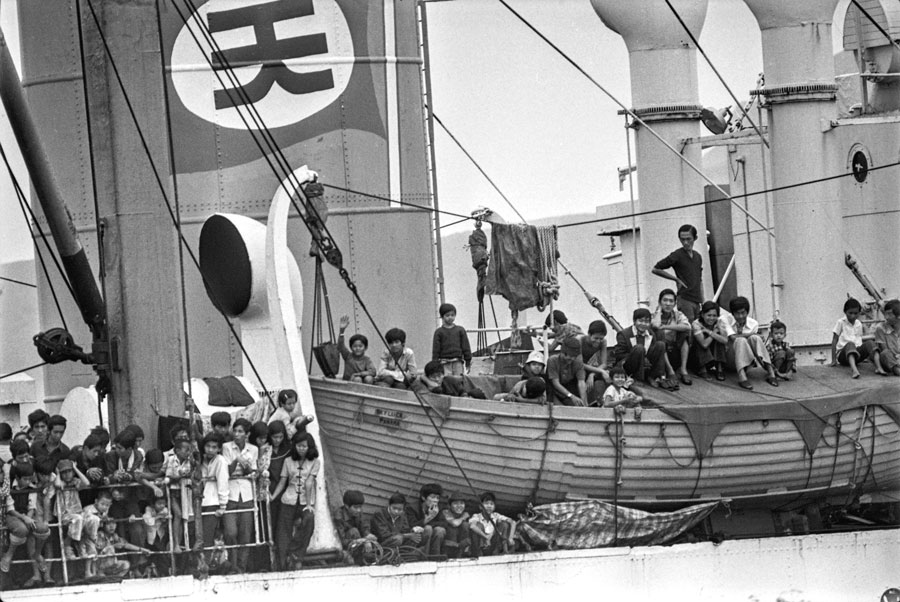
The Skyluck three days after its arrival in Hong Kong. Picture: SCMP
Information quickly obtained from Singapore revealed that the Skyluck had sailed from the Lion City at about 8am on January 12. As well as its captain, it carried 25 crew (10 from Taiwan, 10 from Indonesia, four from Hong Kong and one from Vietnam), no other passengers, and a partial load of paper, corrugated boxes and plywood. With Hong Kong listed as its first port of call, the journey from Singapore would normally have taken about five days for a ship like the Skyluck.
So where had it been for 27 days?
The captain initially claimed multiple breakdowns at sea, and that his freighter had rescued the refugees from sinking or unseaworthy boats it had encountered between January 18 and 21. His unruly new passengers, he alleged, had seized his logbook and radio log, throwing those records of the journey overboard.
Officers of Hong Kong Marine Department and police were deeply sceptical, however, and an investigation began.
Over the weeks that followed, it was ascertained that, on leaving Singapore, the Skyluck had, in fact, sailed for the southern tip of Vietnam, anchoring off the Mekong Delta. During the journey from Singapore, the letters S, C and K had been removed from the ship’s name, the goal being to create confusion should the vessel attract attention and be reported to authorities during its illicit mission. (Chemists from the Forensic Science Division of the Hong Kong police examined paint samples taken from the ship, confirming the hiding and repainting of those letters.)
If they had been successful in dropping us off on some island, and we reported to local government how we had been picked up by a ship called Kylu, then they would search for Kylu. No one would ever have known that the Skyluck had been involved”Andy Tran
The location in the Philippines where the ship offloaded more than 600 refugees was Boayan Island, off the northwest coast of Palawan Island, in Palawan province. The 1,327-hectare island was largely forested and barely inhabited (as it remains, with fewer than 1,000 residents, most involved in the fishing industry).
Sheltered by fisherman until rounded up by the Philippines military, those refugees were transferred to a refugee camp in the city of Puerto Princesa, on Palawan Island, and an Associated Press dispatch released weeks later – in March 1979 – centred on an account smuggled out of that camp.
Allegedly written by Pham Dang Bao, 30-year-old son of late South Vietnam foreign minister Pham Dang Lam (and one of the refugees dropped off in the Philippines), the account stated that gold had been transferred from the Skyluck – “shifted in two sacks” – on January 26, before he left the ship.
The suggestion that a hoard of gold was removed before the Skyluck’s arrival in the Philippines is supported in the writings of veteran Australian journalist Bruce Grant, drawing on the accounts of Southeast Asia correspondents from Australian newspaper The Age and published in late 1979 as a book (long since out of print) called The Boat People. In his account, Grant posited that the Skyluck had left Singapore at much the same time as a Taiwan-owned vessel called the United Faith.
“A few days [after leaving Vietnam] she met the United Faith near Indonesia’s Natuna Islands in the South China Sea,” Grant wrote. “The gold was transferred to the United Faith, which was there ostensibly to supply the refugee carrier with food and water. The Skyluck, rechristened the Kylu by the simple trick of painting out the first and last two letters of its name, then sailed northeast towards Palawan.
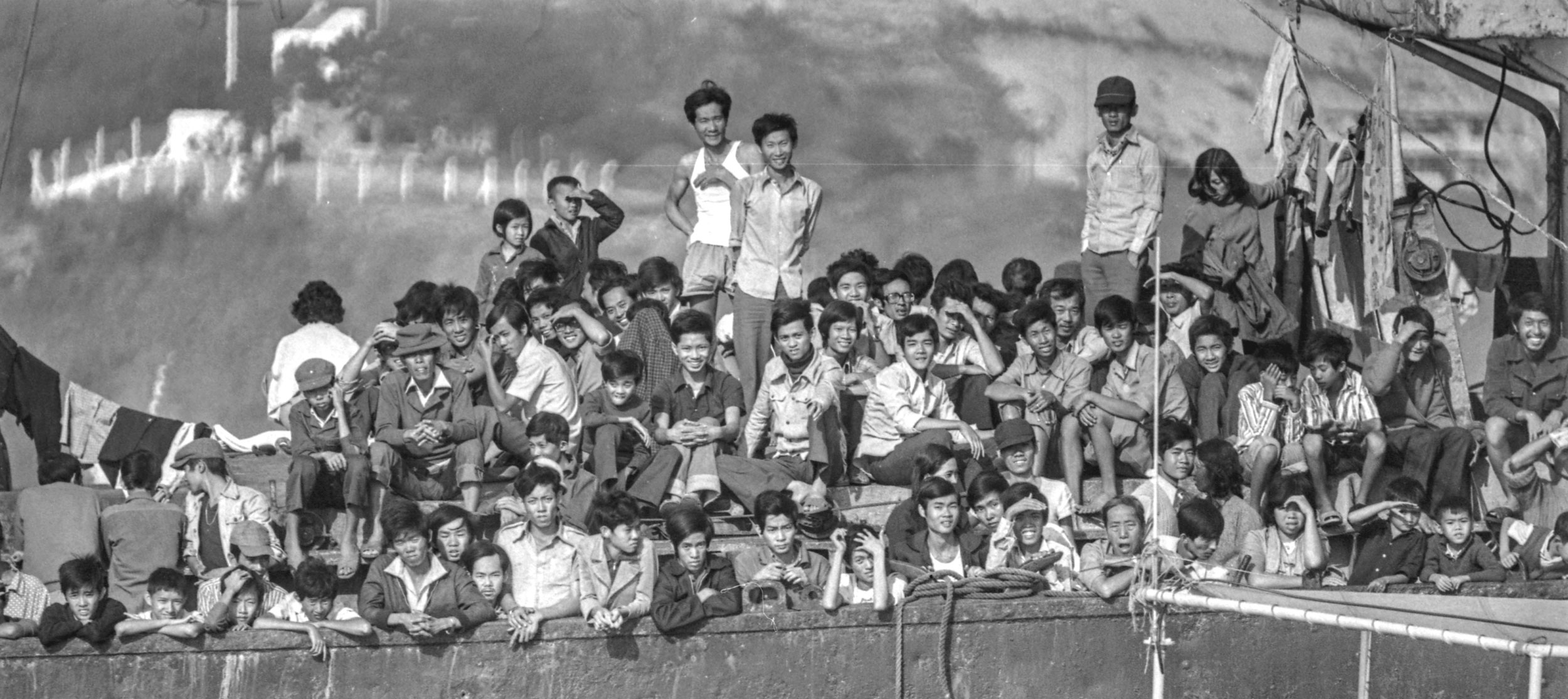
Refugees pack the deck of the Skyluck, anchored off Lamma Island, in February 1979. Picture: SCMP
“The United Faith then made a beeline for Hong Kong where she was met, in international waters, by a fishing boat which offloaded the gold and ferried it undetected into the British territory. ‘A few days later, we saw Vietnamese gold popping up in the local market, but no refugees,’ a Hong Kong official said.”
Indonesia’s Natuna archipelago consists of 272 islands in the south of the South China Sea, off the northwest coast of Borneo, which would tie in with Quan Tran’s assertion that the ship headed south from the Mekong Delta, and that he saw offshore drilling rigs (the area has substantial natural gas reserves, discovered in the early 1970s).
In 1985, however, a Skyluck survivor – by then resettled in New Zealand – told the Post that the gold had been transferred to a “pure white” ship they met off the Philippines one day before the attempt to offload refugees.
Andy Tran argues that, if the attempt to offload all of the refugees in the Philippines had been a success, there would have been no need to remove illicit valuables from the ship, which again suggests that its booty would have been removed later rather than earlier. “If they had been successful in dropping us off on some island, and we reported to local government how we had been picked up by a ship called Kylu, then they would search for Kylu,” he says. “No one would ever have known that the Skyluck had been involved, and they would have gone to Hong Kong as the Skyluck.”
With that strategy thwarted, Andy Tran believes, Hong Kong became the people smugglers’ plan B, but there was a problem. “They knew they could not carry the gold with them because it would also be confiscated, so they had another ship park next to it, and offloaded the gold.”
And on February 24, 1979, the South China Morning Post reported that cryptic ship-to-shore communications, sent as the freighter approached the city, had been traced back by police. One such message – “Pick up auntie” – was believed to have been a request to have something removed from the Skyluck.
Whatever the truth of whether and when the ship had carried a small fortune in 24k gold bars, it was now gone. But with the Skyluck’s arrival in Hong Kong – coming so soon after the refugee and riches-laden Huey Fong – the growing fear was that highly organised people smuggling was under way, and of a magnitude that the tiny territory would not be able to handle.
With more massive ships crammed with refugees reported to be just over the horizon, the nervous city braced itself for an oceanic exodus from Vietnam, and a humanitarian crisis that would stretch Hong Kong’s security forces – as well as its people’s capacity for compassion – to their limits.
Here are some other digital native projects you might want to visit
Or just visit our graphics home page
This site has some features that may not be compatlibe with your browser. Should you wish to view content, switch browsers to either Google Chrome or Mozilla Firefox to get an awesome experience